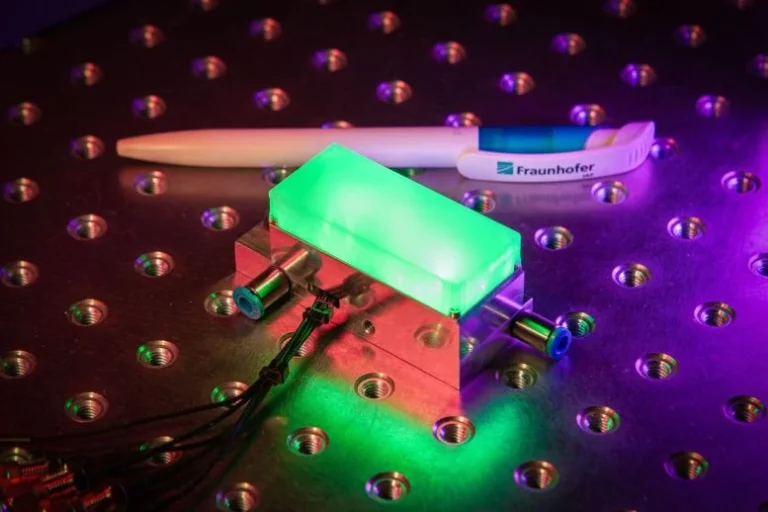New Diamond Magnetometer Paves the Way for GPS-Free Navigation
Fraunhofer IAF presents compact integrated quantum sensor at World of Quantum 2025

Fraunhofer IAF presents compact integrated quantum sensor at World of Quantum 2025
The highly integrated vector magnetometer developed by the Fraunhofer Institute for Applied Solid State Physics IAF uses nitrogen vacancies (NV) in diamond to detect extremely small magnetic fields with a level of flexibility and precision not previously possible.
This miniaturized measurement system opens up new possibilities for applications that demand highly accurate readings with minimal interference, such as biochemical analysis of nerve pathways and precision measurements in microelectronics.
“What makes the diamond-based NV vector magnetometer so special is its native and intuitive functionality, which enables it to precisely measure the vector components of the Earth’s magnetic field under most operating conditions. This makes the sensor not only a technical innovation, but also a significant advance in sensor technology,” explains Dr. Michael Stoebe, Business Unit Manager for Quantum Devices at Fraunhofer IAF.
The unique properties of the NV center in the diamond lattice, aligned along the four crystal axes, make it possible to detect all vector components of a magnetic field using a single sensor chip made from <100> diamond.
This significantly reduces the need for complex calibration and expands the range of potential applications beyond the limits of conventional magnetometers. The sensor is transforming research across multiple fields and marks an important advance in the development of more precise and efficient measurement technologies.
Increased integration density and sensitivity
Researchers at Fraunhofer IAF have successfully reduced the size of their integrated quantum magnetometer by a factor of 30 in just one year. The sensor head is now compact, comparable in size to conventional optically pumped gas cell magnetometers (OPMs) commonly used in industry, while maintaining high sensitivity in the picotesla range. This diamond-based system offers significant advantages over competing technologies due to its robustness and broad measuring range, making it highly adaptable for various measurement scenarios with minimal calibration needed.
“We are striving for even greater integration density, while increasing sensitivity. Our goal for the coming year is to reduce the size of the sensor by a factor of 5 again, while further increasing sensitivity to enable measurements in the sub-picotesla range,” emphasizes Dr. Michael Stoebe.
A key feature of the integrated quantum magnetometers developed by Fraunhofer IAF is their optional water cooling, which allows for stable and reliable magnetic field measurements even under challenging operating conditions. This level of flexibility in design and integration distinguishes the latest sensor prototypes from the Freiburg-based institute.
“We take an application-oriented approach to the continuous development of our sensor systems and respond to the individual requirements placed on our systems,” says Dr. Michael Kunzer, project manager at Fraunhofer IAF.
Alongside system improvements, Fraunhofer IAF is also enhancing the core component of the sensor—the nitrogen-vacancy (NV)-doped diamond sensor head. The synthetic diamond is grown in specialized reactors at the institute and converted into quantum devices by precisely replacing carbon atoms with nitrogen atoms. Plans are underway to expand the current two-inch ultra-pure diamond wafers to four-inch wafers next year, enabling industrial-scale production.
GNSS—Safe navigation without GPS
Despite their high precision and coverage, today’s navigation systems are often prone to interference and are not available everywhere. Alternative navigation methods that function independently of global navigation satellite systems (GNSS) are therefore gaining in importance.
The Earth’s magnetic field is a promising basis for this, as it exhibits regional differences that can be used as an invisible map for autonomous navigation, especially in areas where GPS signals are disrupted or difficult to receive.
The quantum sensor developed at Fraunhofer IAF makes it possible to create comprehensive magnetic field maps and provide reliable navigation based on them. The vector magnetometer offers an autonomous, interference-free method for global positioning and navigation. It complements satellite-based navigation and also works without satellite signals, for example underwater, in canyons, underground, in buildings, or in tunnels.
Geological measurements quickly and contact-free
The quantum magnetometer developed by Fraunhofer IAF enables precise, contact-free localization of underground mineral deposits, thereby providing access to valuable resources. It can also detect unexploded ordnance over large areas, significantly reducing the risk to people in affected areas.
Using the same principle as in navigation, the composition of the Earth’s crust and its magnetic field can be used to draw conclusions about geological formations. Magnetic anomalies such as ore deposits or metallic objects, such as unexploded ordnance, can thus be detected.
The collected data can be converted into magnetic maps that show the locations of suspicious objects and provide information about their depth, shape, and size. This method enables comprehensive and non-invasive exploration of affected areas and the location of even deeply lying objects.
Meeting: World of Quantum 2025
https://scitechdaily.com/new-diamond-magnetometer-paves-the-way-for-gps-free-navigation/
